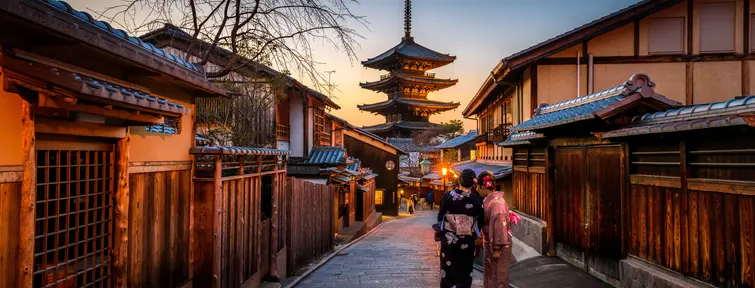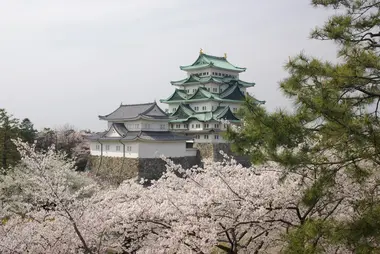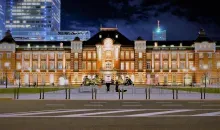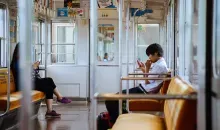How to get from Nagoya to Kyoto
Get from Nagoya to Kyoto, two of the most famous cities in Japan, using the famous Tokaido-Sanyo Shinkansen Line.
How to get to from Nagoya to Kyoto with the Shinkansen bullet train
Kyoto Station
Most travelers to Japan will likely start their journey in Tokyo, and from there, the Tokaido-Sanyo Shinkansen will often take them to other major cities across the archipelago, going south. Two of these major cities are Nagoya in Aichi Prefecture and Kyoto, the ancient capital of Japan, which is a destination rich with historic sites as well as contemporary culture.
These two destinations can be traveled to directly with the Shinkansen bullet train, only a few stops away from each other depending on the exact train being ridden. The shortest travel time is a little over 30 minutes with the Nozomi Shinkansen. Other options, like the Hikari and Kodama, will take a bit more time, but are fully rideable with the Japan Rail Pass. Note that riding the Nozomi Shinkansen entails an additional charge for JR Pass holders to benefit from the express train option. The ease of access between the two cities makes visiting both an essential part of any Japan-traveler’s itinerary!
Tokaido Sanyo Shinkansen bullet trains available on this itinerary:
| Nozomi Shinkansen Bullet Train | Hikari Shinaknsen Bullet Train | Kodama Shinkansen Bullet Train |
Reserving seats on the Tokaido-Sanyo Shinkansen bullet train
On the Tokaido-Sanyo, individual ticket holders and holders of Japan Rail Passes can reserve seats in advance of boarding. Reservations are not always required for these because many of them have non-reserved cars with seats that are available on a first-come, first-served basis. These are often car numbers 1-4.
Shinkansen bullet trains have tickets available with reserved seats to assure room for sitting during transit.
Oversized Baggage on the Shinkansen bullet train
For travelers with large baggage, there are certain requirements that must be met to bring it onto the bullet train. Per Japan Railway regulation, baggage that exceeds a sum of 160cm in dimension (L x W x H) must be placed in the designated oversized baggage section located in the back of the train car, and the owners of such baggage must reserve seats nearby this space. Note that any baggage that exceeds 250cm in total dimensions is not allowed on the Shinkansen at all.
Exceptions for these baggage rules include things like baby carriages, musical instruments in cases, and sports equipment (like bikes, snowboards, etc.) that are also in cases. Note that these regulations are limited to the Tokaido-Sanyo Line. Other Shinkansen lines like the Hokuriku Shinkansen and Limited Express Trains, do not have such regulations or restrictions.
Exploring Nagoya
The crossroads city that serves as the capital of Aichi Prefecture is often listed third among the major Honshu cities, behind Tokyo and Osaka. This city, which has a little over 2 million residents, is well-known for its opulent food culture and historic sites that are situated in the center of the metro area. It's also a great place to begin exploring the more rural parts of southern Gifu and Mie Prefecture's coastline districts.
The varied culinary scene of Nagoya, many of which have local connections, is a popular feature of the city for many residents. In Nagoya, everything made with aka-miso, or red miso, is renowned for its potent flavor. Its name implies that it is quite deeply red in color, and it's utilized in a variety of soup and stew recipes. Chicken wings, or tebasaki, are another staple of Nagoya's cuisine. They are a staple of Nagoya's izakaya food and are usually drenched in a thick, sticky, sweet sauce.
One of the most important historical sites is Nagoya Castle. It was Japan's first castle to receive the title of "national treasure." Despite being built in 1612, Nagoya Castle was restored after being devastated during World War II and is now used as the city's symbol.
It is highly advised that you visit the adjacent prefectures, which are conveniently placed close to Nagoya. Popular secondary destinations include the southern portion of Gifu, which has mountains and rolling valleys with small towns and villages scattered throughout. Furthermore, the neighborhood is well-known for its mino ceramics, and visitors are welcome to visit the studios or shops of a number of working artisans. The northern part of Mie Prefecture boasts rich coasts, and the town of Kameyama contains several historic.
Exploring Kyoto
Japan's historic capital, Kyoto, is a dynamic, historically rich city with 17 different UNESCO World Heritage Sites. Kyoto lies in the Kansai region of Japan, which is known for its vibrant locales and has a diverse range of traditions. Kyoto is often the next stop after Tokyo for tourists traveling the Japan Golden Route.
Two of Kyoto's most well-known landmarks are the temple itself and the climb up Kyomizudera, both of which make for rewarding outings. Go a little off the beaten path and explore the charming shops and restaurants lining the uphill alleys that lead up to the temple! The "gold and silver temples," Ginkakuji and Kinkakuji, then, are powerful symbols of Kyoto's long history.
Kyoto is a major city, but unlike other large cities in Japan, it is surrounded by mountains on three sides and contains a large amount of traditional architecture rather than high-rise buildings. Take advantage of Kyoto's unique geography by taking some time for a leisurely stroll across the surrounding landscape. The two-hour trek from Shogunzuka to Seiryuden, which leads to Chion-in Temple, is one of the easier walks in the area. Experience an unrestricted view of the city from an elevated viewpoint and learn about Kyoto in a way you never would have thought possible. As soon as passengers arrive at Kyoto Station, they are in the center of the ancient capital.
There aren't many cities in the world that can claim to be as unique as Kyoto, having been the first to celebrate its 1200th anniversary in 1997 when the station got a redesign by renowned architect Hiroshi Hara. The station is not as large as other significant stations like Tokyo Station, Shinjuku Station, or even Hakata Station, but it does have a few convenience stores, cafes, and restaurants within. Still, one of the most recognizable aspects of Kyoto Station is the illuminated stairway, whose display changes depending on the season. The popular Ume-yu is a sento bathouse with a nice environment that's ideal for relaxing and spending time in. It's conveniently close to the station.
Staples of the Tokaido-Sanyo Shinkansen
The trip from Nagoya to Kyoto is one that is easily made with an easy flow of access, since Nagoya is a stop before Kyoto from Tokyo. For those making a trek across the Japanese Golden Route, that almost fully utilizes the Tokaido-Sanyo Shinkansen Line, this is a journey that ought not to be overlooked! Use either the Japan Rail Pass or individual tickets that are available for this itinerary.














